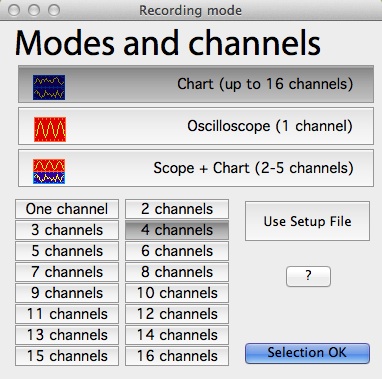|
 Before LabHelper
can acquire data, it must be given a sampling protocol which includes: Before LabHelper
can acquire data, it must be given a sampling protocol which includes:
- the recording mode
- the number of input channels
- sample rates
- the duration of sampling
- matching of logical with hardware channels,
- signal processing and voltage conversion
- signal averaging method
- control of external devices
- triggering options
- screen appearance options
- alarm settings
- audible timer
The initial input window of LabHelper (shown at right) offers
a choice of 1 to 16 channels in three modes of operation:
- Chart
- Oscilloscope
- Oscilloscope plus chart
You can also load a 'setup file' with a complete pre-recorded
sampling protocol (setup files are stored from the OPTIONS
window).
CHART
MODE gathers a fixed amount of data from 1 to 16 channels (up
to two million cases); the operator can intervene at any time to stop acquisition
before the maximum number of samples is obtained. Data
are plotted as separate line graphs for each channel.
Data are stored either under manual supervision (i.e., the operator selects
a new file name for each set of data) or automatically under the autorepeat
option. In autorepeat mode, the operator provides a 'root' file name
before data acquisition starts. Subsequently the program automatically
saves data whenever its buffer is full, appending sequential suffixes (1,
2, 3, 4, etc.) to the file root name for each save. Sample rates for
single channels can be as fast as several hundred per sec if you have a fast CPU and A-D converter,
but are slower if the number of channels
is large.
- If you are using an ADC-1 or DataTaker, the maximum sampling rate is
about 3-4 samples/second.
OSCILLOSCOPE
MODE works like a typical oscilloscope. Data from a single channel are plotted from left to right.
Whenever the next point would 'fall off' the right edge of the screen, plot
position is swapped to the left edge and each new point 'erases' the previous
point at that x-coordinate. The operator provides a 'root' file name
before data acquisition starts. Whenever the TAB key is struck, the
existing screenfull of data is saved under the root name plus a sequential
suffix number (see detailed description in the SETTING
UP section). An oscilloscope screen can contain up to 65,500
samples.
- If you are using an ADC-1 or DataTaker, the maximum sampling rate is
quite low, so
oscilloscope mode is NOT available.
OSCILLOSCOPE
PLUS CHART MODE combines an oscilloscope channel with one to four chart
channels. Sampling rates for oscilloscope and chart channels
are usually quite different. Because this mode is a combination, it is also
a compromise: The oscilloscope channel cannot sample as fast as in 'pure'
oscilloscope mode, sample averaging is keyed to the sample rate of the oscilloscope
channel, and autorepeat is not available.
You should also be aware that if the chart channel sample rate is high,
chart timing may be affected by the time lost when oscilloscope screens
are saved to disk.
- If you are using an ADC-1 or DataTaker, the maximum sampling rate is
quite low, so
oscilloscope plus chart mode is NOT available.
|